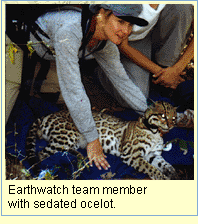| |
 So
far Dr. Carlos López González and Earthwatch teams have
learned that at least 15 carnivore species live in the tropical dry forest
around Chamela. So
far Dr. Carlos López González and Earthwatch teams have
learned that at least 15 carnivore species live in the tropical dry forest
around Chamela.
From tracks of wild cats, photographs by motion-activated cameras,
and actual "captures" the scientists have confirmed evidence of six
different species: jaguar, puma (also known as cougar and mountain lion),
ocelot, margay, jaguarondi, and bobcat. Many other carnivores —
coyote, fox, coatimundi, raccoon, and three different kinds of skunk
— have been captured in traps.
Earthwatch team members set and check the traps. If an animal is caught,
scientists sedate the animal and attach a radio collar so that they
can follow the animal's movements using radio telemetry. Volunteers
help measure and check the animal's physical condition. They also look
for animal tracks in the soft earth, collect scat, and assist in autopsies
of road-killed animals. All of the data helps to provide answers to
key questions:
- How many wild cats are there in the reserve?
- Which areas of the forest do they prefer?
- How much space do they need?
- What are their feeding patterns in relation to other animals in
the forest?
At Chamela the scientists are discovering that wild cats and other carnivores
play a critical role in keeping the forest healthy. As "top predators,"
the wild cats hunt and help to maintain a balance of the prey populations
that they eat (deer, birds, mice, animals and lizards). Without the wild
cats, there might be too many of these prey species, resulting in fewer
plants. A collapse in the number and variety of plants would upset the
entire ecosystem, since plants are the basic food source for all animals.
Through the complex checks and balances of the food web, wild cats and
carnivores help to conserve the diversity of life in the tropical dry
forest.
Photo courtesy
of Julie Bolt
|
 |

